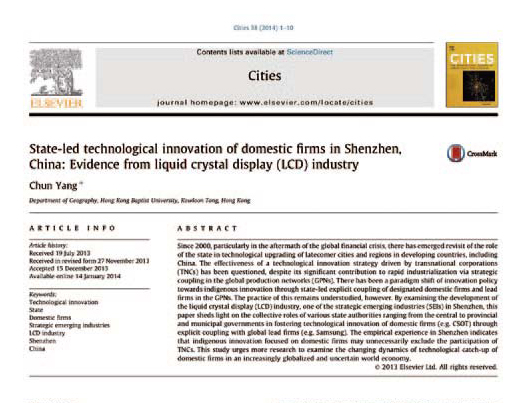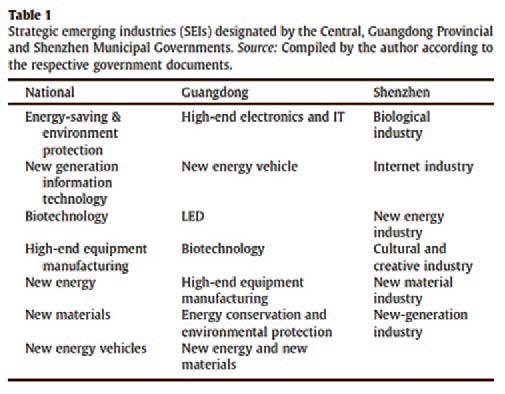After three decades of opening and reform, China, particularly the
Pearl River Delta (PRD) has attempted to change its roles in the global
economy from a low-tech manufacturer to a high value-added
technology-intensive producer. Previous interpretation of the PRD as
a provider of low cost labour for the "global shift" of export-oriented
production is no longer adequate to understand the dramatic transition
in the PRD, particularly the dynamic trajectories of technological
upgrading. Compared with substantial studies on the contribution of
the transnational corporations (TNCs), especially Hong Kong and
Taiwanese firms, little has been conducted on the rise of indigenous
firms and their impacts on technological catch-up and regional
transformation in the PRD. Notably, the 2008 global financial crisis has prompted timely theoretical inquiries and empirical
debates on the export-oriented development which challenges conventional wisdom of technology innovation in the global era.
Taking major cities in the PRD, e.g. Shenzhen and Shunde as cases, this project explores the emergence and transition of regional
innovation systems (RIS) in the post-reform China.
| |
|
|
| |
 |
|
| |
Prof En CHEN |
|
| |
|
|
| |
 |
|
| |
Dr Chun YANG |
|
Through comprehensive field investigations, in-depth interviews
and firm surveys, this project examines the distinctive roles of
diverse actors, viz. the central and local states, TNCs, indigenous
firms, universities and research institutes and their interaction with
the global forces in developing the salient RIS in the PRD. Based
on intensive firm-level case studies in such high-tech sectors as
information and telecommunication (IT), biotechnology, optical
electronics and new materials and energy, the project sheds light
on how and to what extent the rise of indigenous firms from
followers to the major global players in their respective sectors has
brought about the transformation of the PRD. The empirical
experience of the PRD exemplifies the dynamic interactions
between the regional production networks dominated by TNCs
and the regional innovation systems led by indigenous firms under
the interplay between the global and local forces in reshaping
technological catch-up and regional restructuring in the PRD. The
main findings of the project are as follows –
|
|
Firstly, this project elucidates the emerging paradigm shift of
technological innovation in China since the mid-2000s,
characterized by a policy change from expectation of technological
spillover from TNCs to an emphasis on indigenous innovation and
domestic firms. Drawing upon the institutional and evolution
perspective on the RIS approach, the project examines how foreign-invested
and domestic firms have adjusted their innovation
strategies in changing institutional environment through the cases
of light-emitting diode (LED) and liquid crystal display (LCD)
industries as emerging strategic industries. It argues that
government policy change has resulted in the evolution of RIS in
which technological upgrading of foreign-invested and domestic
firms have demonstrated distinctive trajectories.
|
|
|
|
|
| |
 |
|
|
|
Screenshot of Elsevier website (https://www.elsevier.com/):Yang, C., "State-led Technological Innovation of
Domestic Firms in Shenzhen, China: Evidence from Liquid
Crystal Display (LCD) Industry", Cities (2014), Volume 38,
Pages 1-10 |
|
|
|
|
|
|
|
|
Secondly, the study advanced the literature on the roles of the
states in technological upgrading of latecomer cities and regions.
Drawing upon the strategic coupling concept of the global
production networks (GPNs) framework, the project sheds light on
the collective roles of various state authorities ranging from the
central to provincial and municipal governments in fostering
technological innovation of domestic firms through explicit
coupling with global lead firms. The experience in Shenzhen indicates that indigenous innovation focused on domestic firms
may unnecessarily exclude the participation of TNCs. Home
appliance firms in Shunde on the western bank of PRD provides a
vivid case of technological upgrading through strategic coupling
of local firms in the GPNs.
|
|
|
|
|
| |
 |
|
|
|
Extracted from Yang, C., "Strategic emerging industries
(SEIs) designated by the Central, Guangdong Provincial
and Shenzhen Municipal Governments" (2014), Page 3 |
|
|
|
|
|
|
|
|
Thirdly, the study extends the focal notion of GPNs perspective, i.e.
strategic coupling to "de-coupling" and "re-coupling" to illustrate
the interaction among technological upgrading, market reorientation
and spatial relocation of TNCs in the changing context of global-local
dynamics, particularly the aftermath of the global financial crisis. The
project has demonstrated the changing power relations among TNCs
and concerned regions with the emergence of key strategic supplier-led
domestic market-oriented production networks in China.
The study enriches the empirical literature on RIS primarily
dominated by the cases in the western developed countries.
It demonstrates that policies and strategies for technological
catch-up, indigenous innovation and regional transformation
should be formulated in a holistic manner rather than (as hitherto)
on a piecemeal basis in the changing era of globalization.
Dr Chun YANG
Department of Geography
Hong Kong Baptist University
chunyang@hkbu.edu.hk
|
